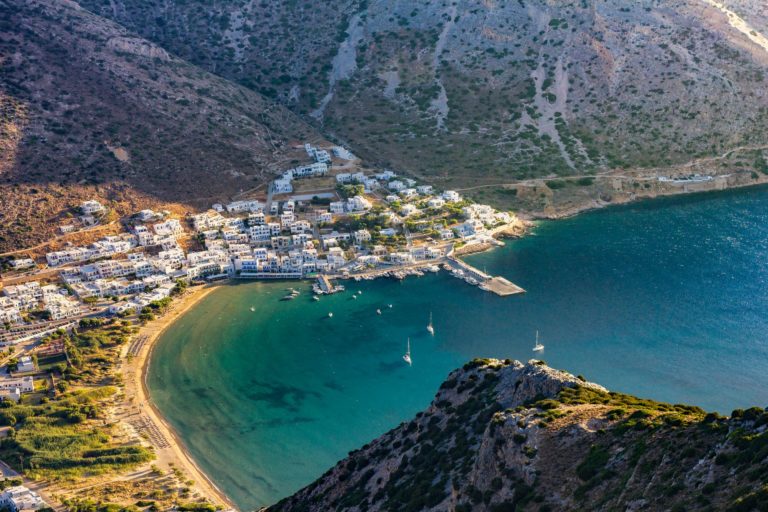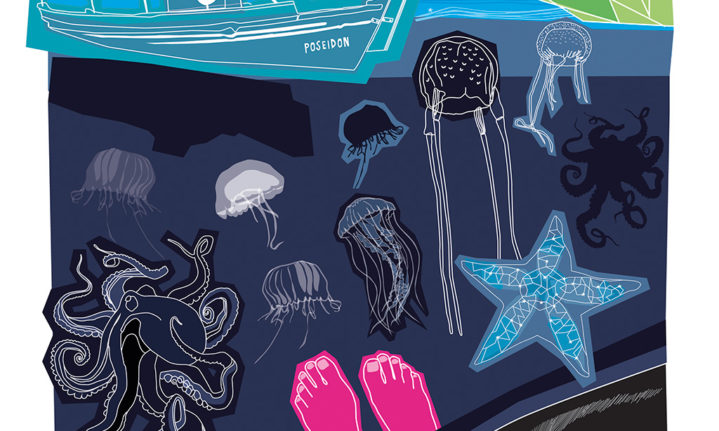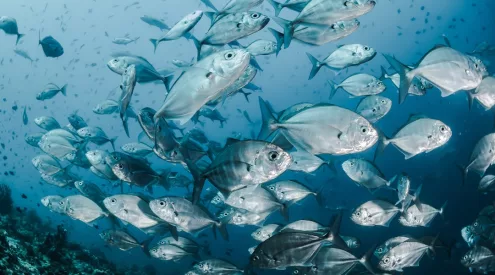Exploring an underwater grotto on the Greek coast leads to an extraordinary discovery.
Words: Dale Morris
In 1997 I was lucky enough to work aboard a traditional Greek fishing boat refitted to ply the coast of Kefalonia with a daily cargo, not of fish, but of tourists. My job, and that of the other six biologists on board, was to conduct informative lectures on the marine wildlife found along the Ionian Islands.

Bottlenose dolphins would often surface nearby or ride our bow wave to the delight of tourists and crew members alike, and occasionally we would be treated to the sight of an endangered logger- head turtle while anchored in a quiet little bay.
One day, when there were no tourists with us, we were checking out new potential snorkelling sites, looking for places rich in fish life and charismatic octopi. What we found instead were giant pulsating jellyfish.
They were moving along the edge of a sheer cliff where the island dropped vertically into calm waters; a place totally inaccessible from the land.
I drifted along with them for a while, transfixed by their otherworldly elegance, but then I noticed a small cave, its darkened entrance a few metres below the water’s surface.
My curiosity piqued, I took in a lungful off air and dived down to take a closer look, noticing that there was a small pocket of air towards the rear. And so I entered.
Within the narrow, long, and gloomy confines of this underwater grotto I spotted all manner of creatures and features. A small crab here, some orange sponges on the roof, a bright blue starfish on the floor and, just as I was running short of breath, I spied two pinkish feet in the murk.
Thinking it was a human body, I shot back out to the surface in shock. Once my head was above water I gulped a quick breath and finned anxiously back down into the cave. The feet turned out to be flippers, and this time I saw they were attached to the black and white body of a Mediterranean monk seal, one of the rarest mammals on earth. There are probably only around 500 of them left.
The pictures I had seen in books had not prepared me for the pure bulk of this creature. I had always imagined they would be similar in size to our fur seals, but this thing was enormous, over two and a half metres in length and built like a hippo.
Oxygen depleted, I surfaced again, this time in the cave’s air pocket, but I was puzzled: why had this animal not swum away? Surely it had sensed my presence, thrashing away with my lime green fins and hyperventilating noisily with excitement.
Even a blind sea urchin should have noticed me.
My third look was exercised with more care and that’s when I saw a wound on one of its swollen flippers. The sort of wound inflicted when an animal gets caught up in fishing gear.
I reluctantly concluded that this terribly rare creature was dead, killed illegally and then stashed underwater to hide the evidence. After all, I had informed many tourists often enough on the plight of monk seals in the Med. How fishermen waged war against them, shooting them on sight or dynamiting their coastal breeding caves.
Overcome with sadness, I solemnly watched the body as it rocked to and fro upon the cave floor and felt an overwhelming urge to touch this creature and bid it farewell.
And so I swam down one last time and placed my palm upon its snout.
That’s when it turned its head and looked at me.
To say that I was surprised would be an understatement, and judging by the bulging eyes of the seal I can only assume the feeling was mutual.
In an instant, it turned around in the narrow confined space, squashing me against the cave wall and causing me to wonder if I might not end up being the first human ever to be killed by a monk seal.
And then it was gone.
I stayed in that cave for a while longer, breathing at the air pocket and coming to terms with what had just happened.
I was later to learn that monk seals can sleep underwater, rising to the surface only to take a gulp of air before sinking back down to continue their siesta unnoticed. I was not aware of this fascinating fact back then.
When I finally swam back to the boat and informed the rest of the crew, we pulled anchor and left, never to return, but to leave this beautiful piece of Greece to the seals and the jellyfish.
As you reflect on the incredible encounter with the Mediterranean monk seal in the hidden underwater cave, it’s worth remembering that Greece has so much more to offer, both below and above the surface. While exploring the wonders of the Greek coast is an unforgettable experience, remember to also indulge in the rich culinary heritage of Greece. If you find yourself in Cape Town, take a moment to savour the flavours of Greece by visiting some of the top Greek restaurants in the city. It’s a delightful way to continue your journey of discovery.
Picture: Unsplahs


















